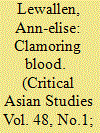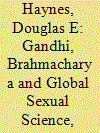| Srl | Item |
| 1 |
ID:
143664


|
|
|
|
|
| Summary/Abstract |
The tension between silence and vocalization, embrace and rejection, of Ainu ancestry has been a key factor in negotiating Ainu subjectivity since Ainu territories were colonized in 1869. As early as 1799, expressions of Ainu ethnicity were alternately cloaked and exaggerated as Japan vacillated between assimilation and segregation policies in eastern Hokkaido Ainu communities. Officially recognized as Japan's indigenous peoples in 2008, Ainu subjectivity has become increasingly politicized as the state and other stakeholders seek to define Ainu ethnicity for future legislation. Today Ainu belonging is frequently gauged by bodily metaphors of a vocalized blood. Cultural sensibility and blood are often conflated in Ainu discourses of identity: Ainu revivalists report that a sensation of “clamoring blood” (J: chi ga sawagu) inspires them to revisit ancestral memories and begin fashioning Ainu identities. Historically, intra-Ainu relations were not bound to blood but instead embodied in material expressions, such as invisible cords for women and crest-like emblems for men, symbols that enabled flexibility where needed. Since the twentieth century, the hyper focus on blood raises the specter of colonially imposed rhetorics of eugenics, assimilation policies, and specifically, the problem of race. Relatedness in the Ainu community is not exclusively defined by “consanguineal relations”; rather, a long history of adopting ethnic Japanese children and non-Ainu into Ainu families renders complex the question of identity. This article assesses how immutable notions of racial difference intersect with self-determination and current articulations of Ainu identity.
|
|
|
|
|
|
|
|
|
|
|
|
|
|
|
|
| 2 |
ID:
177198


|
|
|
|
|
| Summary/Abstract |
This essay explores the evolution of Gandhi’s philosophy of brahmacharya (celibacy) after World War I. I argue here that Gandhi broadened his understanding of brahmacharya after he assumed leadership of the nationalist movement, rendering it into a concept that was applicable to the wider population of India rather than just to himself and a set of especially disciplined activists. A major reason for this development was Gandhi’s concern with deflating the claims of sexual science and birth control at a time when global sexology was gaining a foothold in Indian middle-class society. In this context, Gandhi specifically came to contest the notion that human ‘nature’ made brahmacharya inapplicable to ordinary people, suggested that husbands and wives could follow brahmacharya even while married, and insisted that the general practice of brahmacharya was essential to the collective health of the Indian nation. In the process, he imparted a significant eugenic component into his philosophy.
|
|
|
|
|
|
|
|
|
|
|
|
|
|
|
|